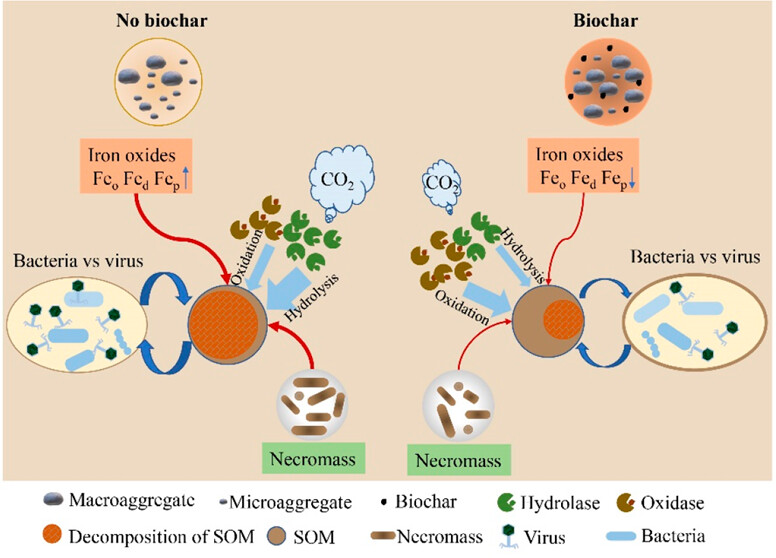Bacteria–virus interactions are more crucial in soil organic carbon storage than iron protection in biochar-ammended paddy soils
November 20, 2023 | Environmental Science & Technology |
Introduction: While iron oxides are thought to protect SOC in oxygen-deprived environments, the role of these oxides, biochar, and microbial interactions in SOC fate remained unclear. In a four-month experiment with rice seedlings under waterlogged conditions, researchers from Chinese Academy of Science investigated the complex interplay of iron oxides, biochar, and microbial communities in influencing soil organic carbon (SOC) dynamics.
Key findings: The study found that biochar significantly impacted soil enzyme activities, particularly in larger soil aggregates. Iron oxides and necromass were found to have negative associations with SOC levels. Notably, bacterial communities demonstrated strong connections with viral communities. Contrary to conventional beliefs, the increase in SOC was not primarily attributed to iron oxides; instead, it was strongly influenced by intricate interactions between bacteria and viruses, with specific keystone ecological clusters and taxa playing crucial roles.
Read more

Fig. | Graphical Abstract.
Viewed Articles
November 20, 2023 | Environmental Science & Technology |Â Â Introduction: While iron oxides are thought to protect SOC in oxygen-deprived environments, the role of these oxides, biochar, and microbial i
Read More
March 21, 2024 | npj Ocean Sustain | Source | Â Introduction: Climate change significantly affects marine ecosystems, exacerbated by overfishing and habitat degradation, weakening the ocean's capac
September 21, 2023 | Nature Communications | Source | Introduction: Human activities are threatening global biodiversity and the ecosystem services provided by mangroves. Current conservation efforts
August, 2023 | Ecosystem Services | Source | Â Introduction: Agricultural intensification in India threatens ecosystem sustainability, with agroforestry identified as a key strategy to mitigate these i
January, 2023 | Renewable and Sustainable Energy Reviews | Source | Â Introduction: Achieving global climate goals requires practical, low-energy negative emissions technologies (NETs). Researchers fro
April 21, 2022 | Nature Ecology & Evolution | Source | Introduction: To combat climate change, ocean afforestation is being explored as a method of carbon dioxide removal (CDR) by introducing coastal





